The Battery Resistance Tester Market is estimated to be valued at USD 65.8 million in 2025 and is projected to reach USD 119.6 million by 2035, registering a compound annual growth rate (CAGR) of 6.2% over the forecast period.
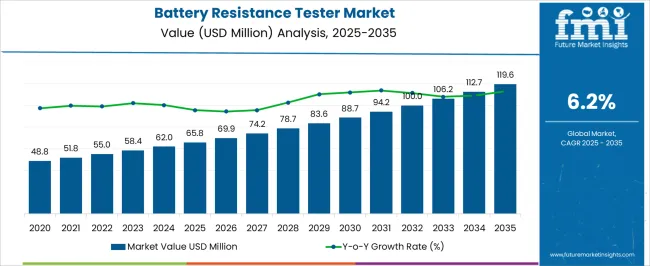
| Metric | Value |
|---|---|
| Battery Resistance Tester Market Estimated Value in (2025 E) | USD 65.8 million |
| Battery Resistance Tester Market Forecast Value in (2035 F) | USD 119.6 million |
| Forecast CAGR (2025 to 2035) | 6.2% |
The Battery Resistance Tester market is being driven by the rising demand for efficient monitoring and maintenance of battery health across various industries. The current market scenario reflects a growing need to ensure performance, safety, and reliability in energy storage systems, electric vehicles, and backup power solutions. Increasing adoption of portable solutions and advanced analytics has further accelerated market expansion, as users seek cost-effective and user-friendly methods to assess battery performance without interrupting operations.
The focus on predictive maintenance and avoiding downtime is contributing to the wider acceptance of resistance testing across sectors. The market’s future outlook is expected to benefit from the surge in electric mobility, renewable energy storage systems, and the need for safe battery management in industrial settings.
Growing investments in energy infrastructure and stricter safety regulations are also influencing market growth As industries increasingly rely on battery-dependent systems, demand for accurate and real-time resistance testing tools is anticipated to rise, creating opportunities for innovation and expansion in both developed and emerging regions.
The battery resistance tester market is segmented by product type, application, end use industry, and geographic regions. By product type, battery resistance tester market is divided into Portable Battery Resistance Testers and Stationery Battery Resistance Testers. In terms of application, battery resistance tester market is classified into Battery Resistance Testers For Standard Batteries and Battery Resistance Testers For Rechargeable Batteries. Based on end use industry, battery resistance tester market is segmented into Battery Resistance Testers For Automotive, Battery Resistance Testers For Aviation, Battery Resistance Testers For Healthcare, and Battery Resistance Testers For IT & Telecom. Regionally, the battery resistance tester industry is classified into North America, Latin America, Western Europe, Eastern Europe, Balkan & Baltic Countries, Russia & Belarus, Central Asia, East Asia, South Asia & Pacific, and the Middle East & Africa.
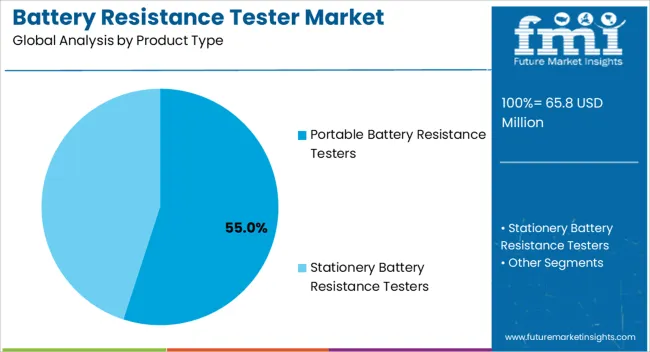
The portable battery resistance testers segment is expected to hold 55.00% of the total revenue share in the Battery Resistance Tester market in 2025. This leadership is being attributed to the rising need for flexible, on-site battery testing solutions that can be easily transported across facilities. Portable devices are being favored for their ability to deliver accurate readings without requiring large setups or additional infrastructure.
The segment’s growth has been supported by increased deployment in sectors such as automotive maintenance, energy utilities, and industrial equipment, where battery performance directly impacts operational efficiency. The adoption of portable solutions is also being driven by advancements in lightweight design, intuitive interfaces, and safety features that reduce user error and enhance testing accuracy.
The ability to conduct resistance measurements without removing the battery has further accelerated the use of portable testers As industries focus on maintaining uninterrupted power supply and optimizing battery lifespan, portable resistance testers are being seen as essential tools for proactive maintenance strategies.
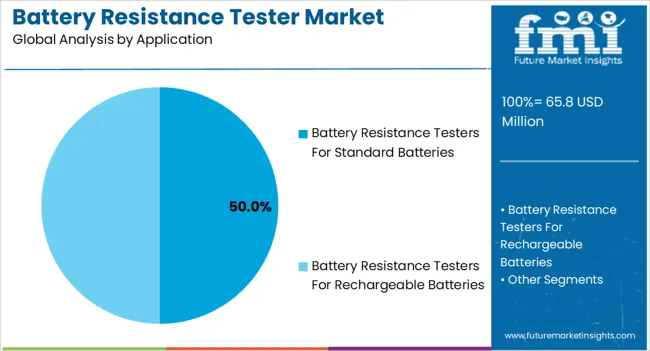
The battery resistance testers for standard batteries segment is projected to account for 50.00% of the market revenue in 2025, making it a leading application area. This dominance is being attributed to the widespread use of standard batteries in consumer electronics, backup power supplies, and industrial equipment. The need to monitor the state of charge, health, and safety of such batteries has prompted greater adoption of resistance testers designed specifically for standard battery chemistries.
The growth in this segment has been supported by the increased reliance on uninterrupted power systems, where battery performance directly influences reliability. Easy-to-use resistance testers that provide rapid diagnostics without requiring technical expertise have further expanded the segment’s reach.
Moreover, the rising awareness about battery aging and the importance of maintenance protocols have encouraged businesses and individuals to invest in testing solutions As battery-powered devices continue to proliferate across both personal and professional settings, the demand for specialized testing tools tailored for standard batteries is expected to remain strong.
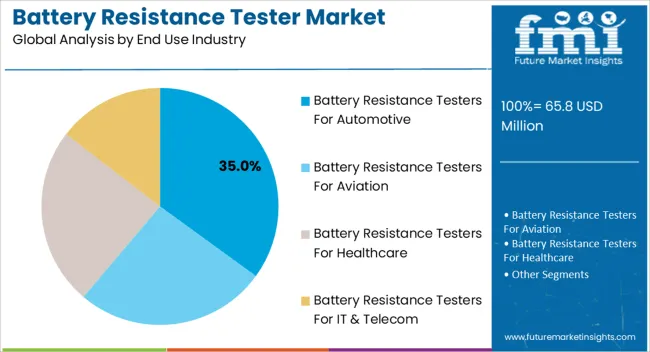
The battery resistance testers for automotive segment is forecasted to hold 35.00% of the total market revenue in 2025. This leading position is being driven by the growing number of electric and hybrid vehicles, where battery efficiency and health monitoring are critical for vehicle performance and safety. Automotive batteries are being subjected to rigorous conditions such as frequent charging cycles, extreme temperatures, and high current draws, making resistance testing an essential maintenance practice.
The segment’s growth has been supported by the increasing complexity of battery management systems and the need for accurate diagnostics to prevent battery failures and optimize energy use. Vehicle manufacturers and service centers are being encouraged to adopt resistance testers that offer quick, reliable readings with minimal downtime.
The shift toward electrification and stringent safety regulations has further prompted stakeholders to invest in automotive-specific resistance testing solutions With the automotive industry’s continued focus on performance optimization and lifecycle management, resistance testers tailored for automotive batteries are being positioned as indispensable tools for maintenance and quality assurance.
Battery resistance testers, multipurpose voltage testers, and resistance testers are all on the rise. Quickly stores and records omic values, temperature, and voltage of strings, cells, and inter-cell connectors, battery resistance testers, a new method gaining traction as user-friendly software becomes more prevalent. Manufacturers are working hard to achieve innovation that is in line with the interests of their customers.
As a result, players in the battery resistance tester market conduct experiments with new features. The battery resistance tester instantly recalls and retests readings on-site for data comparison and trending. This is propelling the battery resistance tester market forward. The battery resistance tester market is expected to grow at a single-digit CAGR owing to these factors.
The global battery resistance tester market has grown significantly as a result of increased demand in the electronics and instrumentation industries, which is expected to boost battery resistance tester manufacturing and sales. The battery resistance tester market has benefited from government support for a holistic approach to instruments.
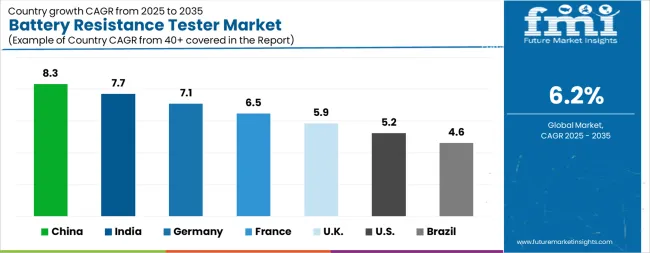
| Country | CAGR |
|---|---|
| China | 8.3% |
| India | 7.7% |
| Germany | 7.1% |
| France | 6.5% |
| UK | 5.9% |
| USA | 5.2% |
| Brazil | 4.6% |
The Battery Resistance Tester Market is expected to register a CAGR of 6.2% during the forecast period, exhibiting varied country level momentum. China leads with the highest CAGR of 8.3%, followed by India at 7.7%. Developed markets such as Germany, France, and the UK continue to expand steadily, while the USA is likely to grow at consistent rates. Brazil posts the lowest CAGR at 4.6%, yet still underscores a broadly positive trajectory for the global Battery Resistance Tester Market. In 2024, Germany held a dominant revenue in the Western Europe market and is expected to grow with a CAGR of 7.1%. The USA Battery Resistance Tester Market is estimated to be valued at USD 24.6 million in 2025 and is anticipated to reach a valuation of USD 41.1 million by 2035. Sales are projected to rise at a CAGR of 5.2% over the forecast period between 2025 and 2035. While Japan and South Korea markets are estimated to be valued at USD 3.0 million and USD 2.0 million respectively in 2025.
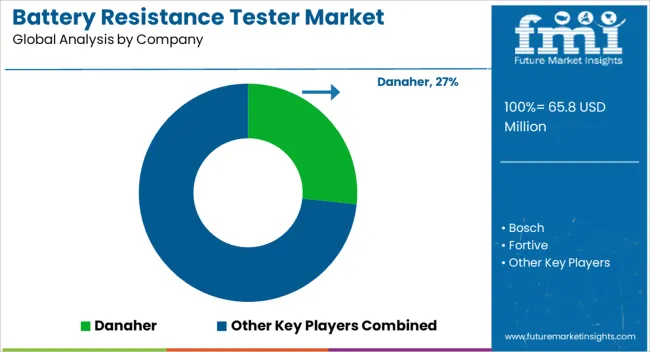
| Item | Value |
|---|---|
| Quantitative Units | USD 65.8 Million |
| Product Type | Portable Battery Resistance Testers and Stationery Battery Resistance Testers |
| Application | Battery Resistance Testers For Standard Batteries and Battery Resistance Testers For Rechargeable Batteries |
| End Use Industry | Battery Resistance Testers For Automotive, Battery Resistance Testers For Aviation, Battery Resistance Testers For Healthcare, and Battery Resistance Testers For IT & Telecom |
| Regions Covered | North America, Europe, Asia-Pacific, Latin America, Middle East & Africa |
| Country Covered | United States, Canada, Germany, France, United Kingdom, China, Japan, India, Brazil, South Africa |
| Key Companies Profiled | Danaher, Bosch, Fortive, ACT Meters, Cadex Electronics, Maccor, West Mountain Radio, Eagle Eye Power Solutions, Transcat, Storage Battery Systems, DV Power, Hioki, and Megger |
The global battery resistance tester market is estimated to be valued at USD 65.8 million in 2025.
The market size for the battery resistance tester market is projected to reach USD 119.6 million by 2035.
The battery resistance tester market is expected to grow at a 6.2% CAGR between 2025 and 2035.
The key product types in battery resistance tester market are portable battery resistance testers and stationery battery resistance testers.
In terms of application, battery resistance testers for standard batteries segment to command 50.0% share in the battery resistance tester market in 2025.






Our Research Products

The "Full Research Suite" delivers actionable market intel, deep dives on markets or technologies, so clients act faster, cut risk, and unlock growth.

The Leaderboard benchmarks and ranks top vendors, classifying them as Established Leaders, Leading Challengers, or Disruptors & Challengers.

Locates where complements amplify value and substitutes erode it, forecasting net impact by horizon

We deliver granular, decision-grade intel: market sizing, 5-year forecasts, pricing, adoption, usage, revenue, and operational KPIs—plus competitor tracking, regulation, and value chains—across 60 countries broadly.

Spot the shifts before they hit your P&L. We track inflection points, adoption curves, pricing moves, and ecosystem plays to show where demand is heading, why it is changing, and what to do next across high-growth markets and disruptive tech

Real-time reads of user behavior. We track shifting priorities, perceptions of today’s and next-gen services, and provider experience, then pace how fast tech moves from trial to adoption, blending buyer, consumer, and channel inputs with social signals (#WhySwitch, #UX).

Partner with our analyst team to build a custom report designed around your business priorities. From analysing market trends to assessing competitors or crafting bespoke datasets, we tailor insights to your needs.
Supplier Intelligence
Discovery & Profiling
Capacity & Footprint
Performance & Risk
Compliance & Governance
Commercial Readiness
Who Supplies Whom
Scorecards & Shortlists
Playbooks & Docs
Category Intelligence
Definition & Scope
Demand & Use Cases
Cost Drivers
Market Structure
Supply Chain Map
Trade & Policy
Operating Norms
Deliverables
Buyer Intelligence
Account Basics
Spend & Scope
Procurement Model
Vendor Requirements
Terms & Policies
Entry Strategy
Pain Points & Triggers
Outputs
Pricing Analysis
Benchmarks
Trends
Should-Cost
Indexation
Landed Cost
Commercial Terms
Deliverables
Brand Analysis
Positioning & Value Prop
Share & Presence
Customer Evidence
Go-to-Market
Digital & Reputation
Compliance & Trust
KPIs & Gaps
Outputs
Full Research Suite comprises of:
Market outlook & trends analysis
Interviews & case studies
Strategic recommendations
Vendor profiles & capabilities analysis
5-year forecasts
8 regions and 60+ country-level data splits
Market segment data splits
12 months of continuous data updates
DELIVERED AS:
PDF EXCEL ONLINE
Ground Resistance Testers Market Growth - Trends & Forecast 2025 to 2035
Automotive Battery Tester Market Size and Share Forecast Outlook 2025 to 2035
Ink Abrasion Resistance Tester Market Size and Share Forecast Outlook 2025 to 2035
Battery Operated Light Market Forecast and Outlook 2025 to 2035
Battery Voltage Recorder Market Size and Share Forecast Outlook 2025 to 2035
Battery Technology Market Size and Share Forecast Outlook 2025 to 2035
Battery Electric Vehicle (BEV) Market Size and Share Forecast Outlook 2025 to 2035
Battery Separator Paper Market Size and Share Forecast Outlook 2025 to 2035
Battery Cyclers Market Size and Share Forecast Outlook 2025 to 2035
Battery Voltage Supervisor Market Size and Share Forecast Outlook 2025 to 2035
Battery Platforms Market Analysis Size and Share Forecast Outlook 2025 to 2035
Battery Management System Market Report – Growth & Forecast 2025-2035
Battery Binders Market Size and Share Forecast Outlook 2025 to 2035
Battery Materials Recycling Market Size and Share Forecast Outlook 2025 to 2035
Battery Packaging Material Market Size and Share Forecast Outlook 2025 to 2035
Battery Energy Storage System Industry Analysis by Battery Type, Connection Type, Ownership, Energy Capacity, Storage System, Application, and Region through 2025 to 2035
Battery Materials Market: Growth, Trends, and Future Opportunities
Battery Electrolytes Market Analysis & Forecast by Type, End-Use, and Region through 2035
Battery Testing Equipment Market Growth – Trends & Forecast 2025 to 2035
Battery Swapping Charging Infrastructure Market Trends and Forecast 2025 to 2035

Thank you!
You will receive an email from our Business Development Manager. Please be sure to check your SPAM/JUNK folder too.
Chat With
MaRIA